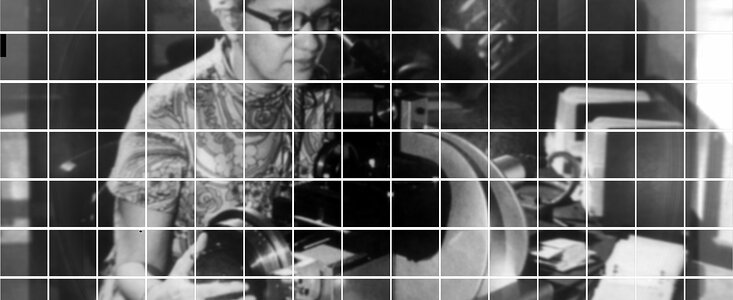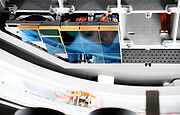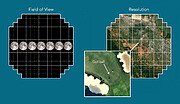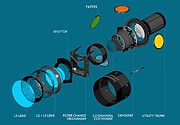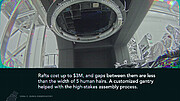Sensores del Telescopio Rubin Capturan su primera Imagen en Laboratorio
Vista previa de la imagen individual más grande del mundo
8 Septiembre 2020
La imagen más grande jamás capturada en una sola toma, una foto digital de 3.200 megapíxeles, fue obtenida recientemente con el conjunto de sensores de imágenes que se integrarán en la Cámara de la Investigación del “Espacio-Tiempo” como legado para la posteridad (LSST por sus siglas en inglés), del Observatorio Vera C. Rubin en el SLAC National Accelerator Laboratory (SLAC). Esta es una exitosa prueba del plano focal de la cámara LSST, que fue completado en enero de 2020.
Una vez que Rubin entre en operaciones, la cámara producirá imágenes panorámicas de todo el cielo del hemisferio Sur —una panorámica cada pocas noches por 10 años. Estos datos alimentarán la Investigación del “Espacio-Tiempo” como legado para la posteridad—, un catálogo que contendrá más galaxias que personas vivas en el mundo, además de los movimientos de incontables objetos astrofísicos. Utilizando la Cámara LSST, el observatorio creará la película más grande de todos los tiempos y arrojará luz sobre algunos de los grandes misterios del Universo, incluyendo la materia oscura y la energía oscura.
El Observatorio Vera C. Rubin y la Cámara LSST del Departamento de Energía, serán operados por Observatorio AURA en Chile a través de su programa NOIRLab de NSF y SLAC.
La primera imagen de laboratorio es tan grande que necesitaría 378 pantallas de televisión 4K de ultra definición para mostrarla en tamaño completo. Para capturar esta foto sin la cámara completamente ensamblada, el equipo de SLAC utilizó un agujero de 0,15 milímetros para proyectar la imagen en el plano focal de 60 centímetros de ancho.
El plano focal de la cámara de LSST contiene 3.200 millones de píxeles, cada uno de 0,01 mm de ancho [1], y el plano focal en sí es extremadamente plano, variando por no más de un décimo del grosor de un cabello humano. Esto permite a la cámara producir imágenes nítidas en muy alta resolución en todo el campo de visión.
En los próximos meses, el equipo de la Camara de LSST en SLAC insertará el criostato con el plano focal en el cuerpo de la cámara y agregará los lentes, el obturador y el sistema de intercambio de filtros de la cámara, lo que la convertirá en la cámara digital más grande del mundo. A mediados de 2021, la cámara —del tamaño de un vehículo SUV— estará lista para las pruebas finales antes de que comience su viaje a Chile para integrarse en el telescopio Simonyi del Observatorio Rubin.
Notas
[1] La cámara tiene un mosaico sin precedentes de 189 sensores de CCD de 4kx4k píxeles. Un total de 3,2 mil millones de píxeles que se pueden leer en apenas 2 segundos.
Más información
La Fundación Nacional de Ciencias (NSF, por sus siglas en inglés) y el Departamento de Energía (DOE, por sus siglas en inglés) apoyarán al Observatorio Rubin en su fase de operaciones para llevar a cabo la Investigación del “Espacio-Tiempo” como legado para la posteridad. También brindarán apoyo para la investigación científica con los datos. Durante las operaciones, los fondos de NSF son administrados por la Asociación de Universidades para la Investigación en Astronomía (AURA), en virtud de un acuerdo de cooperación con NSF, y los fondos del DOE son administrados por SLAC bajo contrato con el DOE. El Observatorio Rubin es operado por NOIRLab y SLAC de NSF.
El Laboratorio Nacional de Investigación en Astronomía Óptica-Infrarroja de NSF (NOIRLab), el centro de EE. UU. para la astronomía óptica-infrarroja en tierra, opera el Observatorio internacional Gemini (una instalación de NSF, NRC–Canada, ANID–Chile, MCTIC–Brasil, MINCyT–Argentina y KASI – República de Corea), el Observatorio Nacional Kitt Peak (KPNO), el Observatorio Interamericano Cerro Tololo (CTIO), el Centro de Datos para la Comunidad Científica (CSDC) y el Observatorio Vera C. Rubin. Está administrado por la Asociación de Universidades para la Investigación en Astronomía (AURA) en virtud de un acuerdo de cooperación con NSF y tiene su sede en Tucson, Arizona. La comunidad astronómica tiene el honor de tener la oportunidad de realizar investigaciones astronómicas en Iolkam Du’ag (Kitt Peak) en Arizona, en Maunakea, en Hawai, y en Cerro Tololo y Cerro Pachón en Chile. Reconocemos y apreciamos el importante rol cultural y la veneración que estos sitios tienen para la Nación Tohono O’odham, para la comunidad nativa de Hawai y para las comunidades locales en Chile, respectivamente.
Enlaces
- Versión aumentada de la imagen
- Comunicado de prensa de SLAC con más imágenes incluidas.
- Anuncio en el sitio web del Observatorio Vera C. Rubin
- Serie de fotos que muestran el montaje del plano focal de la cámara LSST, de principio a fin.
Contactos
Amanda Kocz
Press and Internal Communications Officer
NSF’s NOIRLab
Cell: +1 626 524 5884
Email: akocz@aura-astronomy.org

